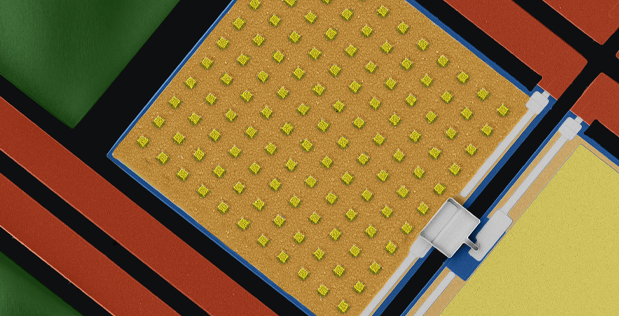
Researchers at Northeastern University have developed an infrared sensor that can be always on but also essentially zero power, a combination that could drive applications in the Internert of Things (IoT).
The work for the US DARPA agency is led by Electrical and Computer Engineering Associate Professor Matteo Rinaldi and uses a plasmonically-enhanced micromechanical photoswitch.
The sensor uses a grid of nanoscale patches whose specific dimensions limit them to absorb only particular IR wavelengths. “The charge-based excitations, called plasmons (that can be thought of somewhat like ripples on the surface of water), are highly localized below the nanoscale patches and effectively trap specific wavelengths of light into the ultra-thin structure, inducing a relatively large and swift spike in its temperature,” said Rinaldi. These temperature spikes, in turn, lead to an upstream sequence of events that culminates in circuit-completing deformations of other parts of the sensor.
“What is really interesting about the Northeastern IR sensor technology is that, unlike conventional sensors, it consumes zero stand-by power when the IR wavelengths to be detected are not present,” said Troy Olsson, manager of the N-ZERO Program in DARPA’s Microsystems Technology Office. “When those IR wavelengths are present and impinge on the Northeastern team’s IR sensor, the energy from the IR source heats the sensing elements which, in turn, causes physical movement of key sensor components. These motions result in the mechanical closing of otherwise open circuit elements, thereby leading to signals that the target IR signature has been detected.”
“The technology features multiple sensing elements—each tuned to absorb a specific IR wavelength,” said Olsson. “Together, these combine into complex logic circuits capable of analysing IR, which opens the way for these sensors to not only detect IR energy in the environment but to specify if that energy derives from a fire, vehicle, person or some other IR source.”
A primary goal of the N-ZERO program is to develop fundamental technologies that open the way to new and more capable sensor systems. The NU team points to the IoT with hundreds of billions of devices, ranging from cars, to appliances, to remotely deployed sensors. “The capability of consuming power only when useful information is present will result in nearly unlimited duration of operation for unattended sensors deployed to detect infrequent but time-critical events, with a groundbreaking impact on the proliferation of the Internet of Things,” said Rinaldi.

No comments:
Post a Comment